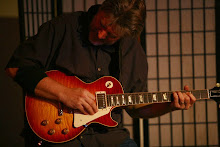diggity shwag 3/2/2005 9:02 PM
How are functional and non-functional harmony used in songwriting? Can both be used within a single composition? Is that something that is commonly done? I have no clue. Help. thangx ;-)
marcbabin 4/16/2005 10:23 AM
Do you mean by functional diatonic and non functional altered or atonal??
diggity shwag 4/17/2005 4:04 PM
"Do you mean by functional diatonic and non functional altered or atonal??"I think so. Sort of. Maybe not atonal per se. I mean, diatonic chords are moving towards their goal and that's how you place the changes knowing that the tonic of the key is their destination. But then with modes you don't have all of that happening and you're just kind of droning on the modal root. So let's say you get tired of droning on that one modal root and you want to go somewhere else because you feel that a change should occur. Where do you go? You want to modulate right? So I guess I'm trying to figure how to put that together (or if I can) with regular diatonic changes. And also I wouldn't mind any insights on root movement of chords that don't follow a diatonic pattern. I mean any chord can follow any other chord if it sounds good right? Could anyone shed some light on any of this stuff?
Don Mock 4/20/2005 2:42 AM
Let me take a shot at this. A lot of great question/ideas, but maybe we should separate a few of these issues to be clear on each. First, how about some terminology. Jazz players and composers tend to think of the word diatonic as meaning "relating to" or "part of" etc. Some even use the word when talking about any key center which might include harmonic or melodic minors. Ebmaj#5, for example, is "diatonic to the key of C harmonic minor etc. But it's probably best to stick to the major scale when using the word. In my world the term "functioning" is almost always attached to a dominant 7th chord. Functioning dominants always take you somewhere else usually, but not always, the tonic chord. (G7 to Cmaj7 or A7 to Dm7 etc. Dominant 7ths that are stationary like the ones in blues, rock or funk are sometime called "static dominants." Static dominants can usually have extensions added (9th, 11th, 13th) but not usually alterations (#5, b9 etc). The one big exception in modern music is adding the #9 to a static dominant. (Check out my little lesson on "The Hendrix Chord" here on the site.) One right thing you said is that any chord can follow any chord if it sound good. There really are no strict rules on how one constructs a tune. Although, the chord moves that sound great usually follow some logic or harmonic movement that works and can probably be traced to some classical rule. Traditional tunes and jazz standards are loaded with common short progressions such II-V-I and I-VI-II-V's. You can connect these progressions from key to key all day long and will always sound correct. Randomly play turnarounds in any key to any key and you will see that you can't sound wrong. We can call this kind of composing "diatonic progressions" even though we might be changing keys every bar. Some other terms that you might hear relating to improvising and composing are modal and parallel chord movements. During the fusion era in the '70's and '80's everyone was writing tunes with parallel moves. Heck, just take an A11 or G/A chord and slide it around to different keys every bar or so. Instant fusion. Entire tunes are written with one chord played in several keys. My tune St. Clair is nothing more than an dominant 11th played in about 6 keys. And these 11th's are considered "static" dominants so you won't hear much in the way of altered sounds.Modal writing is using the mode names to not only tell you which scale you are in but also the harmony or chords. When you think about it, writing out tunes using this approach makes a lot of sense. If I see on a chart a bar of D Dorian, I have all the information I need to not only improvise but comp too. D Dorian is nothing more that a C major scale for soloing and for chords I can play Dm, Dm7, Dm9, Dm11 and any Dm chords with extensions or additions from the key of C. If the next bar has F Phrygian, off to the key of D flat and the same thing. D flat for my key center and notes from Db added to the Fm chord. Well I've skimmed over a lot of ideas here but the bottom line is all this leads us back to the need for a clear knowledge of harmony and theory. And learning theory is easy, it's using it in a creative and musical fashion that can take a life time to master.-Don Mock
Subscribe to:
Post Comments (Atom)

No comments:
Post a Comment